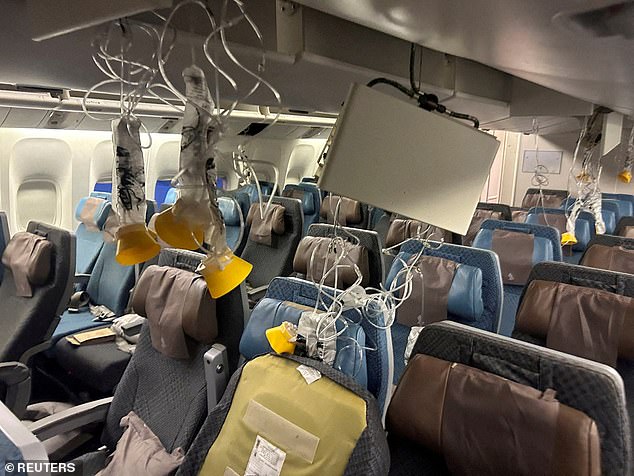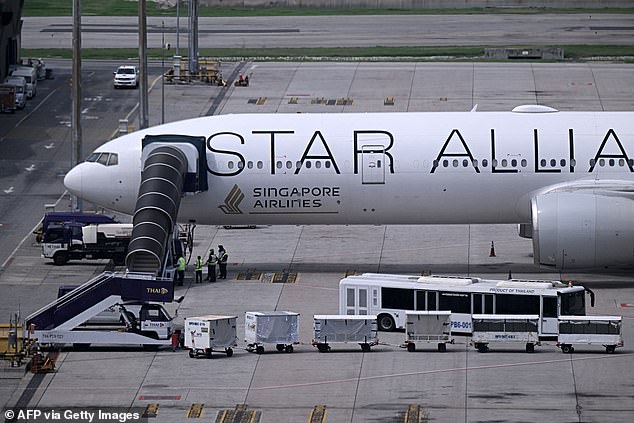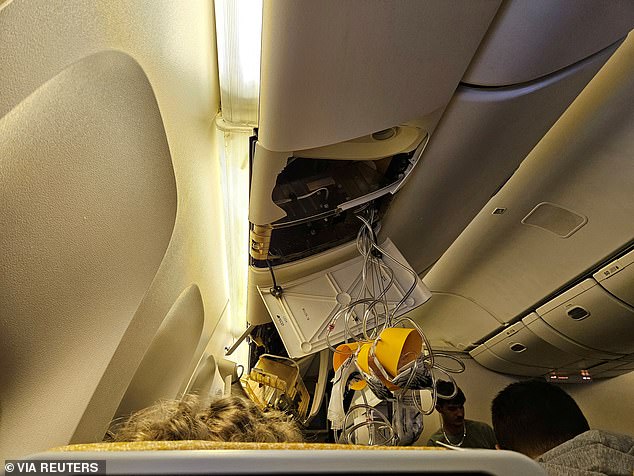A passenger aboard the turbulent Singapore Airlines flight that left a British grandfather dead has heartbreakingly revealed he suffered six neck and spinal fractures.
Bradley Richards, 29, said he was knocked unconscious and woke up with blood pouring from his head after flight SQ321, from London to Singapore, encountered turbulence over Myanmar.
Another passenger, Geoff Kitchen, 73, from Thornbury, near Bristol, died of a suspected heart attack, while many more were injured when the plane fell 178 feet in just 4.6 seconds and suffered a rapid change in force. g.
Richards, a telecommunications engineer from Benfleet, Essex, described the experience as “something out of a movie” and fears he will not be able to continue in his line of work after suffering life-changing injuries.
After using a pillow to stop blood flow, he says he “immediately felt pain in his spine” and had to be lifted into a wheelchair when the plane landed in Bangkok.

Bradley Richards, 29, was knocked unconscious and woke up with blood pouring from his head after flight SQ321, from London to Singapore, hit turbulence over Myanmar.

The May 21 flight on a Boeing 777-300ER aircraft carrying 211 passengers and 18 crew diverted to Bangkok for an emergency landing after the plane was hit by turbulence.

Musical theater director Geoffrey Kitchen, 73, has tragically died after suffering a suspected heart attack.
Early findings from the Transportation Safety Investigation Bureau (TSIB) show that the plane experienced a rapid change in up and down acceleration, causing injuries to those not wearing seat belts.
Mr Richards said: “I was asleep or I think I might have been unconscious when it happened.”
“I remember waking up and my head was full of blood, kids were screaming, people were running everywhere, it was very frantic.
‘It was like something out of a movie.
‘I remember feeling the pain in my back immediately and blood pouring from my head.
‘I tried to use my cushion to stop the blood, one of the ones they give out on flights.
‘Once we landed, I was near the back of the plane and I remember the medical staff running around and having to step over all the injured people on the ground.
“They couldn’t get me a stretcher, so they helped me get off the plane.
‘I told them about my spinal pain and the workers had to lift me up, hold me under my armpits and take me to a wheelchair.

Singapore Airlines said it acknowledged the report and was cooperating fully with the investigation.

The plane was rocked by turbulence that threw passengers and crew around the cabin.

“I’m guessing they couldn’t get a stretcher in the back because of the people on the floor or they may not have picked it up because of all the chaos that was going on.
“To be honest, I was a little quiet afterwards, it all seemed so surreal.” I didn’t scream or anything.
“It was all very traumatic. When I woke up and saw people on the ground, on a stretcher, as I say, it seemed like something out of a movie, not real life.’
Doctors have told Mr Richards it is unlikely he will be able to return to work in his current role as an engineer.
He said: “It’s just heartbreaking – I’ve worked in that role for seven years and couldn’t imagine doing anything else.”
Richards has been receiving treatment in a Bangkok hospital and is currently unsure when he will be able to return to the UK.
He suffered multiple fractures to his spine and neck, a spinal epidural hematoma and a head laceration that required 20 stitches.
He said: “It hasn’t been pleasant, I can tell you, but I do my best to stay positive and the airline and the hospital have been so good to me that the medical care is second to none.”
At the time of writing, it has raised £3,570 in GoFundMe to help pay for “injury-related expenses not covered by Singapore Airlines or any other third party upon returning home to the UK.”
The results of the TSIB’s preliminary investigation reveal that the plane fell 54 m (178 ft) in just four seconds.
The agency says it likely caused the injuries to the crew and passengers.
The Boeing 777-300ER plane carrying 211 passengers and 18 crew diverted to Bangkok for an emergency landing after the plane was hit by turbulence that threw passengers and crew around the cabin, hitting some against ceiling.
‘The plane experienced a rapid change in G (gravitational force). “This likely caused the occupants who were not buckled up to become airborne,” Singapore’s Transport Ministry said in a statement.
‘Vertical acceleration changed from negative 1.5G to positive 1.5G in 4 seconds. “This probably caused the airborne occupants to fall back down,” he said, citing information gleaned from flight data and cockpit voice recorders.
“The rapid changes in G during the 4.6-second duration resulted in an altitude drop of 178 feet, from 37,362 feet to 37,184 feet. This sequence of events likely caused injuries to the crew and passengers,” he added.

